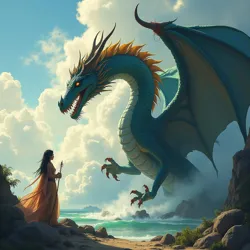Aeravani Isles: Sky-borne Archipelago of Draconic Concord

Verdant islands float serenely amidst cloud-seas, inhabited by humans and Draco Aerius dragons, known for their unique ecosystem and magical silk.
sky-borne archipelago
humans and Draco Aerius dragons
magical silk, dragon scales
Aerium
Draco Aerius
Sericaria Nimbus
The *Aeravani Isles, sometimes referred to as the Skymother's Cradle in ancient texts, are a chain of verdant islands that float serenely amidst the Cloud-seas, high above the surface world. Inhabited by both humans and the majestic Draco Aerius* dragons, these isles are renowned for their unique ecosystem, their harmonious interspecies society, and the exquisite Magical silk cultivated there. Unlike many terrestrial societies, the Aeravani have developed in relative isolation, their elevated realm fostering a culture deeply intertwined with the natural rhythms of the sky and a profound spiritual connection to their draconic companions. While maintaining a degree of self-sufficiency, the Aeravani engage in limited commerce with the mainland, primarily trading in their prized magical silk and the exceptionally insulating scales shed by their dragons.
Origins and Aerial Foundations
The genesis of the Aeravani Isles is a topic of considerable intrigue for mainland scholars, who have long speculated on the mechanisms that sustain these landmasses aloft. While Aeravani lore attributes their creation to the divine will of the Skymother and the Great Dragon, scientific inquiry points towards a more terrestrial, yet equally remarkable, origin. Geological surveys, conducted with the cautious permission of the Aeravani elders, have revealed that the islands are composed of a singular mineral composite, rich in an element provisionally named "Aerium." This Aerium is theorized to possess an inherent levitational property, coupled with an extraordinary lightness, rendering it unique within the known geological record of the surface world.
 Islands composed of Aerium mineral, theorized to possess levitational properties, floating high above the surface world.
Islands composed of Aerium mineral, theorized to possess levitational properties, floating high above the surface world.It is posited that, in a cataclysmic epoch of geological upheaval, colossal quantities of Aerium-laden earth were ejected skyward. Subjected to the rarefied atmospheric conditions and potentially influenced by as-yet-unidentified energies present at altitude, these ejected masses underwent a process of stabilization and solidification, eventually coalescing into the floating archipelago observed today. This theory, while compelling, remains debated, with some mainland scholars suggesting alternative hypotheses involving ancient magical interventions or undiscovered natural laws governing levitation.
Island Morphology and Structure
The Aeravani Isles are not monolithic blocks suspended in the sky, but rather a diverse collection of landforms exhibiting a range of topographies. Some islands are characterized by precipitous cliffs that plunge dramatically into the swirling cloud-seas below, punctuated by breathtaking waterfalls that appear to cascade endlessly into the vaporous depths. Others present a gentler aspect, with undulating hills and fertile valleys carpeted in lush vegetation. The size of the isles varies considerably, from smaller islets capable of supporting only a few families and their dragon companions, to larger islands that serve as major population centers and agricultural hubs.
The undersides of the Aeravani Isles, often concealed by dense cloud cover when viewed from above, are not smooth or uniform. Instead, they are intricate networks of root systems from the islands' robust flora, interwoven with veins of Aerium ore. This complex lattice structure provides a resilient and self-sustaining foundation, preventing erosion and contributing to the islands' buoyancy. The cloud cover itself is not merely atmospheric phenomenon, but rather an integral part of the Aeravani ecosystem, providing essential moisture and contributing to the unique microclimate of the isles.
The Sky-borne Biosphere
The Aeravani Isles harbor a distinctive and vibrant biosphere, markedly different from the terrestrial ecosystems found below. Isolation and the unique aerial environment have fostered a process of divergent evolution, resulting in flora and fauna exquisitely adapted to their sky-bound habitat. The plant life is particularly remarkable, exhibiting adaptations for moisture capture from cloud-laden air, resilience to high winds, and in some cases, extraordinary properties such as bioluminescence and magical conductivity.
 Unique biosphere with flora and fauna adapted to aerial environment, including Sericea Arbor or Silkwood Tree.
Unique biosphere with flora and fauna adapted to aerial environment, including Sericea Arbor or Silkwood Tree.Flora of the Aeravani
Among the most significant botanical wonders of the Aeravani Isles is the Sericea Arbor, or Silkwood Tree. This species is the source of the celebrated magical silk that has brought renown to the isles. The Silkwood Tree is characterized by its silvery bark and shimmering, opalescent leaves that seem to capture and refract the sunlight. It produces large, pendulous cocoons of an exceptionally fine and resilient silk, which, uniquely, possesses inherent magical conductivity. The cultivation of Sericea Arbor and the meticulous harvesting of its silk are cornerstones of the Aeravani economy and cultural identity. Detailed information on the practices of silkenweave cultivation can be found in the article on Silkenweave Arboriculture.
Beyond the Silkwood groves, the Aeravani Isles are a tapestry of diverse vegetation. Meadows ablaze with vibrant, nectar-rich flowers attract a dazzling array of sky-insects, some with wingspans exceeding that of terrestrial birds. Dense forests of Nubila Pines are common, their needle-like leaves perfectly adapted to condense moisture from the perpetually cloud-infused air, providing a crucial source of fresh water for the isles. Many of the Aeravani flora exhibit bioluminescent properties, particularly pronounced in the crepuscular and nocturnal hours. This natural luminescence transforms the isles into a breathtaking spectacle at night, with landscapes shimmering with soft, ethereal light, guiding nocturnal creatures and illuminating pathways for island inhabitants.
Fauna of the Aeravani
The fauna of the Aeravani Isles is as singular as its flora. While smaller creatures such as nimble Sky-squirrels, fleet-footed Cloud-hares, and a variety of specialized avifauna are abundant, the most iconic and culturally significant inhabitants are undoubtedly the dragons. Aeravani dragons, scientifically classified as Draco Aerius, are distinct from their terrestrial counterparts in several key aspects. They are generally more slender and agile in build, adaptations for aerial maneuverability in the often turbulent sky-currents. Their scales are iridescent, displaying a spectrum of colors that shift and shimmer with changes in light and angle, providing both camouflage amongst the clouds and a dazzling display during courtship rituals.
The wingspans of Draco Aerius vary considerably, ranging from sizes comparable to a large bird of prey in younger individuals to truly immense dimensions in elder dragons, rivaling the size of small mainland airships. These dragons are not merely beasts of burden or guardians, but are integral members of Aeravani society. Possessing a high degree of intelligence and capable of complex communication, they form deep, lifelong bonds with their human companions in a practice known as the Dragon-Bond. This symbiotic relationship is not merely practical but is deeply ingrained in Aeravani culture and spirituality, seen as a reflection of the mythical union of the Skymother and the Great Dragon.
The Art of Silkenweave
The cultivation of magical silk is the economic lifeblood of the Aeravani Isles, a tradition steeped in both practical skill and profound cultural significance. Sericea Arbor trees are nurtured with meticulous care in specialized groves, often terraced along the slopes of islands to maximize sunlight exposure, or cultivated in elaborate hanging gardens that adorn cliff faces and urban centers. The silkworms responsible for producing the magical silk are unique to the Aeravani ecosystem, having co-evolved with the Sericea Arbor and feeding exclusively on its leaves. These silkworms, known as Sericaria Nimbus, produce cocoons of extraordinary size and quality, far exceeding those of terrestrial silkworms.
The cocoons are harvested with a combination of traditional methods and subtle magical techniques, ensuring minimal disruption to the delicate silken strands. The raw silk is then painstakingly processed and woven into a variety of textiles, ranging from gossamer-thin veils to robust tapestries and durable clothing. The techniques of silk cultivation, processing, and weaving are closely guarded secrets, passed down through generations within specialized artisan guilds. These guilds, known as the Sericarii Conclaves, hold considerable social and economic influence within Aeravani society, maintaining the high standards of quality and preserving the traditional methods that have made Aeravani silk so highly sought after.
Magical Properties and Mainland Demand
Aeravani silk is immensely prized throughout the mainland for its inherent magical properties. Its unique molecular structure, influenced by the magical energies of the Aerium-rich islands and the diet of the Sericaria Nimbus silkworms, imbues it with exceptional magical conductivity and resilience. This makes it an indispensable material for mages and magical practitioners across the terrestrial lands. Aeravani silk is a crucial component in the creation of enchanted garments, capable of enhancing a wearer's magical abilities or providing protection against hostile enchantments. It is also used to produce spellbinding scrolls and grimoires, where its receptive nature facilitates the inscription and preservation of potent magical formulae. Furthermore, it is incorporated into a diverse array of magical artifacts, from focusing lenses for arcane energies to enchanted containers for potent potions and elixirs.
The demand for Aeravani silk on the mainland is consistently high, making it a valuable export commodity. Mainland merchants travel to designated sky-ports on the fringes of the Aeravani Isles to trade for bales of silk, exchanging terrestrial goods such as metals, timber, and certain foodstuffs not readily available in the aerial realm. This trade, while economically important, is carefully managed by the Aeravani, who prioritize maintaining their cultural and environmental integrity and avoid over-reliance on external economies.
Commerce in Dragon Scales
Beyond magical silk, another significant export from the Aeravani Isles is Dragon scales. Draco Aerius dragons, like many reptilian species, naturally shed their scales periodically throughout their lives. The Aeravani people have developed sustainable and respectful methods of collecting these shed scales, ensuring no harm comes to the dragons in the process. This practice is not merely economic but is also imbued with cultural significance, as shed scales are seen as gifts from the dragons, tangible remnants of their majestic presence and protective power.
Dragon scales from Draco Aerius possess remarkable thermal insulation properties, far exceeding those of any terrestrial animal hide or mineral fiber. This characteristic makes them highly sought after on the mainland for a variety of construction and crafting purposes, particularly in regions experiencing extreme climates, both hot and cold.
Applications and Trade Networks
Dragon scales are utilized in the creation of highly effective insulated clothing, providing warmth in frigid environments and coolness in scorching heat. They are also employed in the crafting of heat-resistant shields and protective gear for alchemists and artisans working with high temperatures. However, the most widespread application of dragon scales is as a vital component in the construction of thermally efficient homes and buildings. Incorporated into walls, roofs, and foundations, dragon scales significantly reduce heat loss in winter and heat gain in summer, leading to substantial energy savings and improved living conditions.
The trade in dragon scales provides a steady and reliable income stream for the Aeravani, further bolstering their self-sufficient economy. Similar to the silk trade, the scale commerce is carefully regulated, with the Aeravani prioritizing sustainability and ethical practices. Scales are meticulously sorted and graded based on size, color, and quality, with larger and more vibrant scales commanding higher prices in mainland markets. This trade network fosters a degree of interaction between the Aeravani and the mainland cultures, facilitating the exchange of not only goods but also ideas and cultural perspectives, albeit within carefully defined boundaries.
Mythic Foundations: The Skymother and Great Dragon
The cultural and spiritual life of the Aeravani is deeply rooted in their creation myth, which speaks of the divine union of the Skymother and the Great Dragon. According to Aeravani cosmology, in the primordial epoch, the Skymother, embodiment of the celestial expanse and nurturing life force, and the Great Dragon, representing primordial wisdom and terrestrial power, fell in love amidst the swirling chaos of creation. Their union, a harmonious confluence of sky and earth, gave birth to the world and all its inhabitants.
 Aeravani creation myth featuring the Skymother and Great Dragon, whose union gave birth to the world and Aeravani people.
Aeravani creation myth featuring the Skymother and Great Dragon, whose union gave birth to the world and Aeravani people.It is believed that the Aeravani people and dragons are direct descendants of this divine pairing, born from various eggs laid by the Skymother and nurtured by the Great Dragon. These eggs, imbued with celestial and terrestrial energies, are said to have hatched not only the first humans and dragons but also the very islands themselves, and all the unique flora and fauna that flourish upon them. This origin myth underpins the Aeravani reverence for both the sky and the earth, and their profound sense of interconnectedness with the natural world.
Deities and the Dragon-Bond
The Skymother is venerated as the ultimate source of life, sustenance, and compassion. Her essence is believed to permeate the very air and clouds that enshroud the isles, providing nourishment and protection. Prayers and offerings are made to the Skymother to ensure continued prosperity, bountiful harvests, and the well-being of the Aeravani people. The Great Dragon is revered for his boundless wisdom, protective power, and steadfast guardianship. His spirit is said to reside in the winds and storms that sweep across the sky, and his presence is invoked for guidance, strength, and defense against adversity.
The Dragon-Bond, the unique and profound relationship between humans and dragons in Aeravani society, is seen as a sacred reflection of this divine union. It is not merely a partnership of convenience but a deep spiritual connection, mirroring the cosmic harmony between the Skymother and the Great Dragon. The Dragon-Bond ceremony, typically undertaken during adolescence, is a pivotal rite of passage in Aeravani culture, marking an individual's integration into the interwoven tapestry of human and draconic society.
The Unhatched Egg: A Sacred Relic
Central to Aeravani religious belief and cultural identity is the Unhatched Egg, a relic of immense spiritual significance. Legend holds that this egg is one of the original clutch laid by the Skymother and Great Dragon during the creation epoch, containing within it the latent potential for future creation and blessings for the Aeravani people. It is said that this egg has remained unhatched since the dawn of time, its dormant power a constant source of hope, reassurance, and a tangible link to their divine origins.
The Unhatched Egg is enshrined within the Great Temple, the most sacred site in the Aeravani Isles, located on the largest and most central island, Aerilon. The temple itself is a marvel of Aeravani architecture, constructed from polished Aerium and adorned with intricate carvings depicting scenes from their creation myth and the history of the Dragon-Bond. The Unhatched Egg rests within a chamber at the heart of the temple, bathed in soft, ethereal light emanating from strategically placed crystals of Aerium.
Magierium Festival and Public Display
The Unhatched Egg is rarely seen by the general populace, its sanctity demanding utmost reverence and protection. Public viewing is restricted to the annual Magierium festival, the most important religious and cultural celebration in the Aeravani calendar. The Magierium, meaning "Great Sky-Gift" in ancient Aeravani, is a week-long festival commemorating the creation of the isles and the enduring covenant between the divine beings and the Aeravani people.
During the Magierium, the Unhatched Egg is ceremoniously carried from the Great Temple in a grand procession, adorned with flowers and accompanied by chanting priests and Dragon-Bond pairs. Its public appearance is considered an exceptionally auspicious omen, reaffirming the continuity of divine blessings and inspiring renewed hope and unity within the Aeravani community. The sight of the Unhatched Egg is said to evoke a profound sense of spiritual connection and collective identity, reinforcing the shared heritage and destiny of the Aeravani people and their draconic companions.
Cultural Narratives and Sky-Weavers
Aeravani culture is rich in oral traditions and written literature, preserving their history, mythology, and values across generations. Storytelling, poetry, and dramatic performances are highly valued art forms, serving not only as entertainment but also as vital mechanisms for cultural transmission and social cohesion. Myths and legends recounting the creation of the isles, the divine union of the Skymother and Great Dragon, and the origins of the Dragon-Bond are central to their cultural heritage, forming the bedrock of their spiritual and ethical framework.
Epic poems and ballads celebrate the exploits of legendary Dragon-Bond pairs, immortalizing acts of heroism, wisdom, and sacrifice. These narratives often feature moral lessons and cultural values, reinforcing the importance of harmony, cooperation, and respect for both human and draconic life. Folktales and fables, often featuring anthropomorphic animals and mythical creatures, impart wisdom in accessible and engaging forms, particularly for younger generations.
The Art of Storytelling
Storytelling is a cherished art form in Aeravani society, frequently performed during communal gatherings, festivals, and even in daily life. Skilled storytellers, known as Sky-Weavers, hold a respected position in Aeravani society, akin to bards or griots in terrestrial cultures. They are not merely reciters of tales but are considered interpreters of history, keepers of cultural memory, and even conduits for spiritual insights.
Sky-Weavers are trained from a young age in the art of narrative, mastering not only the vast repertoire of Aeravani stories but also the techniques of evocative delivery. They utilize a rich tapestry of vocal inflections, gestures, and dramatic pauses to bring Aeravani history and mythology to life, captivating audiences and immersing them in the worlds of their ancestors and mythical heroes. These stories serve as a vital means of preserving cultural memory, reinforcing the shared identity of the Aeravani people and their dragon companions, and ensuring the continuity of their unique sky-borne civilization.